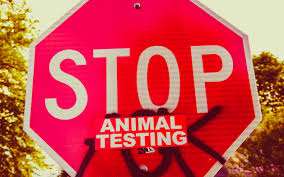THE DANGERS OF ANIMAL TESTING

Using animals to test out drugs, cosmetics, and other products is a very common practice for companies around the world. According to Cruelty Free International, 115 million animals are used for testing every year and according to PETA, more than 110 million of them are killed. The treatment of these animals is far from humane as they are forced to undergo severe physical and psychological trauma.
Animal testing is used due to the similarities between human biology and that of species such as the rats, frogs, guinea pigs, monkeys, cats, and dogs that are used in expirements. Theoretically, the similarities allow experimenters to gauge whether a product is safe for human use based on the animal’s biological reactions. When testing cosmetics, the products are rubbed on the animals, including in their eyes or down their throat. Many view these procedures as a necessary precaution to protect humans from health hazards that could arise from a variety of products.
However, while they are similar, animal and human biology do differ in various and significant ways. According to Cruelty Free International, “animals do not naturally get many of the diseases that humans do,” leading them to be “artificially induced in animals in laboratories,” prior to testing out drugs and cures for illnesses.
This discrepancy can lead to inaccurate results and drugs being approved for use that pose a danger to human health.
According to the National Institute of Health (NIH), “evidence demonstrates that critically important physiological and genetic differences between humans and other animals can invalidate the use of animals to study human diseases, treatments, pharmaceuticals, and the like.”
In addition, animals used for testing are held captive in laboratories, away from their natural habitat. This deprivation of their needs causes extreme stress leading to psychological and physical damage.
The NIH stated that the conditions of laboratories “can prevent species-typical behaviors, causing distress and abnormal behaviors among animals.”
The daily procedures that animals are put through in laboratories are a constant cause of stress for them. They also often develop contagious anxiety, meaning that they develop symptoms of anxiety such as increased heart rate and cortisone levels while seeing others of their species being harmed or killed in experiments.
According to the NIH, “stress related changes in physiological parameters caused by the laboratory procedures and environments can have significant effects on test results,” possibly invalidating the results altogether.
According to a 2018 Pew Research Center poll, 52 percent of Americans oppose the use of animals in scientific research and typically, those who do not oppose it only feel that way because they think it is a necessity. However, animal testing is clearly proven to not only be unnecessary, but also dangerous to humans. The torture that so many animals are put through leading to their death combined with the inadequacy of results from this kind of expirementation should be enough to bring an end to a method that has continued for far too long.

Hi I'm Chelsea, I'm a senior and one of the editors of the paper. I love music and the environment.









